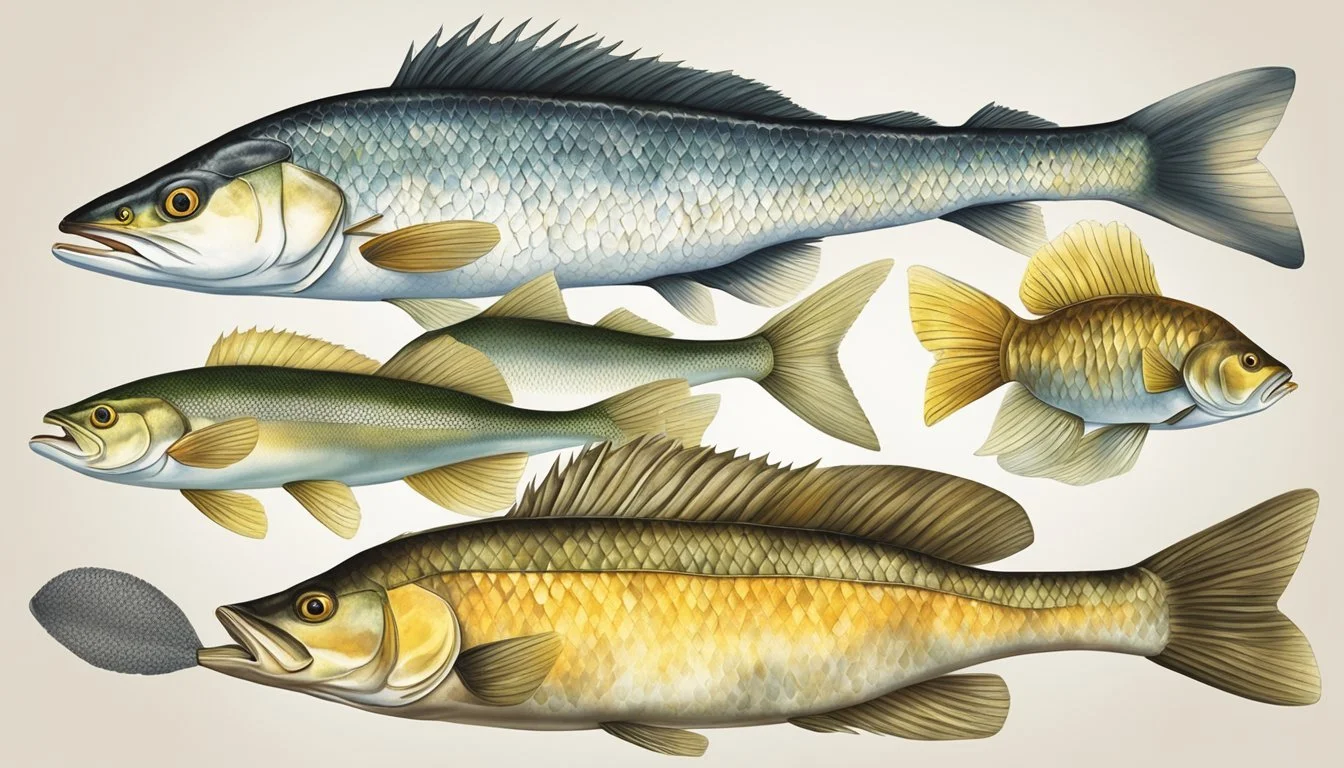Tilapia Substitutes
Best Alternatives for Every Recipe
Finding a suitable alternative to tilapia in recipes can seem challenging, but there are several excellent substitutes that offer similar taste and texture while maintaining nutritional value. Red snapper provides a delicate, moist, and sweet flavor that closely mirrors tilapia, making it a top choice. Additionally, farmed striped bass is notable for its moderately firm texture and mild taste, providing a sustainable option for health-conscious cooks.
Another versatile substitute is branzino, a type of bass known for its mild taste with a hint of sweetness and firm, flaky texture. It works well in various culinary applications, from fish tacos to fish sticks. For those looking for a more flavorful alternative, mullet, with its nutty, sweet flavor and firm meat, presents an ideal swap for tilapia, especially in stews and soups.
These substitutes ensure that you can continue to enjoy your favorite tilapia recipes without compromising on flavor or nutrition.
Understanding Tilapia
Tilapia is a popular white fish known for its delicate, mild flavor and firm texture. This makes it versatile for various cooking methods, including baking, grilling, and frying.
Nutritionally, tilapia is noteworthy for its low calorie content and being a good source of protein. A typical 100g serving provides essential amino acids that support body tissue repair and growth.
Additionally, tilapia contains omega-3 fatty acids, which are crucial for cardiovascular health and brain function. These nutrients are part of what makes tilapia a beneficial part of a balanced diet.
Tilapia is often farm-raised through sustainable aquaculture practices. Specifically, U.S. farm-raised tilapia is held to high standards to ensure both environmental responsibility and the healthfulness of the fish.
Here is a brief overview of tilapia’s nutritious profile per 100g serving:
Nutrient Amount Calories 96 kcal Protein 21 g Total Fat 1.7 g Omega-3 Fatty Acids 0.2 g
These attributes make tilapia a nutritious and accessible option for many diets. Its attributes align well with modern dietary needs, providing a mix of essential nutrients.
Qualities of Substitutes
When choosing substitutes for tilapia, it is essential to consider several qualities that make them good replacements.
Many substitutes share a mild flavor that appeals to a broad audience. Fish like red snapper and branzino are known for their mild, slightly sweet taste, making them ideal for those who enjoy tilapia.
Firm texture is another critical attribute. Fish such as flounder, striped bass, and mullet provide a firm yet flaky texture, closely matching that of tilapia. This quality is crucial for dishes like fish tacos and fish sticks.
Nutrient content also plays a significant role. Substitutes for tilapia should offer similar protein levels. Fish like catfish and sole are rich in proteins, ensuring the body receives essential amino acids necessary for muscle repair and growth.
Omega-3 fatty acids are vital for cardiovascular health and brain function. Substitutes such as red snapper and mullet contain ample amounts of omega-3s. This makes them not only tasty but also beneficial for maintaining overall health.
Versatility in cooking methods is a desirable quality in substitutes. Suitable alternatives should adapt to various cooking techniques like baking, grilling, and frying. Species like branzino and flounder offer this versatility, making them excellent options for diverse recipes.
Sustainability is a growing concern for many consumers. Choosing fish that are sourced sustainably helps preserve marine ecosystems. Substitutes such as striped bass are often farmed or sourced from well-managed fisheries, adhering to sustainable practices.
A table summarizing some key qualities:
Substitute Mild Flavor Firm Texture High Protein Rich in Omega-3 Versatile Sustainable Red Snapper Yes Yes Yes Yes Yes Yes Branzino Yes Yes Yes Yes Yes No Flounder Yes Yes Yes No Yes No Striped Bass Yes Yes Yes Yes Yes Yes Mullet Yes Yes Yes Yes No No
This information assists in selecting the best substitute for tilapia based on specific qualities and needs.
Popular Tilapia Alternatives
Several fish varieties can substitute tilapia in recipes, each with unique textures and flavors. These alternatives provide similar culinary versatility and can be prepared using various cooking methods like frying, grilling, or baking.
Catfish
Catfish is a popular choice, especially in US Southern cooking. It's often fried and served with a crisp coating. The flesh of catfish is moist and sweet, making it a great substitute for tilapia. Catfish fillets hold up well in various recipes and pair excellently with robust seasonings. This freshwater fish has a slightly firmer texture than tilapia, making it suitable for dishes that require a sturdier fish.
Red Snapper
Red Snapper boasts a firm texture and mild, sweet taste, making it another excellent tilapia alternative. Found predominantly in the Gulf of Mexico, red snapper fillets are versatile; they can be baked, grilled, or fried. Rich in Omega-3 fatty acids, this fish not only substitutes tilapia in many dishes but also provides added health benefits. Its vibrant flavor profile makes it a favorite in many seafood dishes.
Rainbow Trout
Rainbow Trout is known for its delicate, moist flesh and slightly sweet flavor. This freshwater fish is a versatile option for replacing tilapia in recipes. Rainbow trout is suitable for baking, grilling, and even smoking, offering a mild taste that pairs well with a variety of seasonings. The fish's flaky texture and nutritional content, including Omega-3 fatty acids, make it a nutritious and delicious choice.
Striped Bass
Striped Bass can be found both wild and farmed, offering a firm texture with a mild flavor. This white fish is very adaptable, suitable for baking, grilling, or even making fish tacos. Striped bass has a richer flavor profile when wild-caught compared to its farmed counterparts. It serves as a great substitute for tilapia in various recipes, providing a versatile option for fish dishes.
Branzino
Branzino, also known as European sea bass, is a slightly sweet and delicate fish, offering a buttery flavor. Commonly found in the Mediterranean Sea, branzino has a firm texture and is often baked whole or grilled. Its taste is mild yet flavorful, making it an excellent tilapia substitute. Branzino's skin crisps up beautifully when cooked, adding an extra layer of texture to dishes.
Salmon
Salmon provides a rich, distinct flavor that differs somewhat from milder white fish like tilapia but offers a good nutritional boost with high levels of Omega-3 fatty acids. Salmon is known for its flaky texture and versatility in cooking methods, including grilling, baking, and smoking. This oily fish pairs well with various herbs and spices, making it a fulfilling substitute for tilapia in many recipes.
Flavor and Texture Match
When seeking a substitute for tilapia, it’s crucial to find a fish with a mild flavor and a moist texture. Tilapia is known for its neutral taste that easily complements a variety of seasonings and cooking methods.
Flounder is a great match in terms of both flavor and texture. It has a delicate, mild flavor and a flaky texture that is very similar to tilapia.
Catfish offers a slightly firmer texture but still maintains a mild and neutral taste.
Striped Bass is another suitable alternative. It provides a moderately firm texture and a neutral flavor that works well in various dishes, whether baked, broiled, or grilled.
Branzino, a type of bass, brings a fresh, mild taste with a hint of sweetness. Its firm texture becomes incredibly flaky when cooked, making it an excellent substitute.
Red Snapper can be a bit sweeter but has a moist texture similar to tilapia. It's a good option when you want a slight variance without straying too far from the familiar taste of tilapia.
Mullet presents a nutty, sweet flavor and firm texture. Use this fish when you need a robust yet mild taste.
Quick Reference Table
Fish Flavor Texture Flounder Mild, delicate Flaky Catfish Mild, neutral Firm Striped Bass Neutral, mild Moderately firm Branzino Mild, sweet Firm, flaky Red Snapper Mild, sweet Moist Mullet Nutty, sweet Firm
These alternatives offer similar textures and flavors, making them excellent choices to replace tilapia in various recipes.
Cooking Methods for Fish Substitutes
Various cooking techniques can bring out the best flavors and textures in fish substitutes. Baking, grilling, frying, pan-searing, and stewing are versatile methods that can be adjusted based on the type of fish used, such as red snapper, catfish, or haddock.
Baking Alternatives
Baking fish substitutes is a straightforward method that retains moisture and enhances natural flavors. Preheat the oven to 375°F to 400°F. Season the fish fillet, such as flounder or striped bass, and place it on a lightly oiled baking sheet.
Bake for 12 to 20 minutes, adjusting for thickness. For a richer taste, use herbs and lemon slices. This method is ideal for moderately firm textures, ensuring the fish remains tender and moist.
Grilling Options
Grilling imparts a smoky flavor and is perfect for firm-textured fish like red snapper and rainbow trout. Preheat the grill to medium-high heat. Brush the fish with olive oil and season as desired.
Grill each side for 3 to 5 minutes, ensuring it doesn’t stick. The high heat gives a crispy exterior while keeping the interior moist. Using a grill basket can help manage delicate fillets and prevent flaking.
Frying Favorites
Frying provides a crispy texture, common in southern cooking with catfish. Heat oil to 350°F. Coat the fish in a seasoned flour or cornmeal mixture.
Fry for 4 to 6 minutes until golden brown. This technique suits white fish varieties with firm textures as they hold up well during frying. Serve with tartar sauce or use in fish tacos for a delightful crunch.
Pan-Searing Selections
Pan-searing is quick, enhancing flavors with a caramelized crust. Use delicate fish like haddock or sole fillets. Heat a pan over medium-high heat with a small amount of oil.
Cook the fillet for 2 to 3 minutes per side, pressing gently to ensure even cooking. This method keeps the inside tender while giving a beautiful golden-brown exterior. Ideal for quick dinners with minimal prep.
Stewing and Soups
Stewing and soups enhance the rich flavors of the fish. Use firm fish like mullet or moderately firm textures. Simmer in a broth with vegetables and spices.
Cook for 15 to 20 minutes until fish is cooked through. This method is great for adding depth to dishes and is adaptable for various recipes, from hearty stews to light soups. Incorporate in fish tacos or serve over rice for a complete meal.
Health and Nutrition Considerations
Tilapia is known for being a lean source of protein. A 4-ounce serving of tilapia provides around 23 grams of protein. This makes it an excellent choice for those looking to build and repair body tissues.
Calories are relatively low in tilapia. A typical serving contains approximately 110 calories, making it a diet-friendly option for many.
Tilapia also contains omega-3 fatty acids, though in lower amounts compared to fatty fish like salmon. Omega-3s are essential for cardiovascular health and brain function.
In terms of vitamins, tilapia is a good source of Vitamin B12. This vitamin is crucial for nerve function and the production of DNA. A single serving can provide a significant portion of the daily recommended intake.
Magnesium is another important nutrient found in tilapia. It helps with muscle and nerve function, blood sugar control, and blood pressure regulation.
Different fish can offer similar health benefits. For example, striped bass and red snapper are also high in protein and omega-3 fatty acids. They can serve as excellent substitutes with comparable nutritional profiles.
Here is a table summarizing the nutritional content per 100g of tilapia:
Nutrient Amount per 100g Calories 110 kcal Protein 23 g Omega-3 Fatty Acids 100 mg Vitamin B12 1.05 µg Magnesium 30 mg
These nutritional considerations make tilapia and its substitutes viable options for a balanced diet.
Sustainable Seafood Choices
Sustainable seafood choices are essential for preserving marine ecosystems and ensuring long-term availability. When selecting fish as an alternative to tilapia, it's important to consider eco-friendly options.
Striped Bass is a great choice. Both farmed and wild striped bass are available, offering a firm texture and mild flavor.
Branzino, a type of bass, is another excellent substitute. Known for its mild taste and firm, flaky texture, branzino is often farmed using sustainable methods.
Mullet stands out with a distinct flavor and firm texture. Found in coastal waters worldwide, mullet can be an accessible and suitable choice for various dishes.
To help with selecting sustainable fish, consult guides like Seafood Watch, which rates seafood choices based on their environmental impact. Fish rated as a "Best Choice" have minimal negative impact on wildlife and the ecosystem.
Here's a quick reference table:
Fish Type Sustainability Texture Flavor Striped Bass Farmed & Wild Sustainable Firm Mild Branzino Sustainable Farming Firm, Flaky Mild, Slightly Sweet Mullet Wild-Caught Sustainable Firm Distinct
When choosing any seafood, consider its method of production. Aquaculture with eco-friendly practices can be an excellent way to ensure a consistent supply without harming wild populations.
Sustainable seafood not only supports the health of the oceans but also offers a variety of flavors and textures for culinary exploration.
Where to Buy Fish Substitutes
Purchasing fish alternatives to tilapia can be both convenient and varied. Options include local fish markets and online platforms.
Fish Markets
Local fish markets often provide a variety of fresh and wild-caught fish. In the U.S. and Canada, these markets usually offer species like striped bass, red snapper, and branzino. These markets are particularly good options for finding sustainable choices.
Online Retailers
For those who prefer shopping from home, several online retailers specialize in seafood. Websites like VitalChoice and FreshDirect offer a range of tilapia substitutes. They ensure freshness by packaging and shipping fish quickly. These retailers often provide detailed information on sourcing and sustainability practices.
Supermarkets
Many supermarkets, such as Whole Foods and Trader Joe's, stock high-quality fish. Sections dedicated to fresh seafood typically include options like flounder and branzino. Labels indicating whether the fish is farmed or wild-caught can help in making informed choices.
Specialty Stores
Some specialty grocery stores focus on seafood. These stores often provide an array of fresh and frozen fish, including mullet and striped bass. They cater to specific culinary needs and may offer recommendations on preparation methods.
Farmers' Markets
Farmers' markets are another excellent source of fresh fish. Vendors at these markets frequently sell locally sourced and sustainable fish, making them ideal for eco-conscious consumers. Options may vary by region and season.
Sustainable Sources
Look for stores that emphasize sustainable fishing practices. Certifications like MSC (Marine Stewardship Council) ensure that the fish you buy supports environmental sustainability.
Utilizing a mix of these sources helps in finding the freshest and most sustainable tilapia substitutes available.
Plant-Based and Vegetarian Alternatives
For those looking for plant-based and vegetarian options to replace tilapia, tofu stands out as a versatile choice. When marinated properly, tofu can take on diverse flavors. It's an excellent source of protein, making it a popular option in vegetarian cooking.
Seitan, made from wheat gluten, is another protein-rich substitute. It has a chewy texture that mimics meat, making it a great addition to dishes requiring a firmer bite.
Cauliflower also serves as a popular alternative. When prepared correctly, it can absorb various seasonings and takes on a tender texture. It provides a whole food option with a mild flavor profile that pairs well with numerous sauces and spices.
For those interested in a homemade touch, carrot lox can be a delightful addition. It involves marinating carrot strips in ingredients like rice vinegar and lemon juice to infuse them with a tangy flavor. This creative option offers a different taste experience.
Comparison Table
Substitute Protein Source Texture Notes Tofu Yes Soft, Firm Versatile and absorbs flavors Seitan Yes Chewy Excellent meat-like texture Cauliflower No Tender Mild flavor, absorbs seasonings Carrot Lox No Thin, Tender Marinated for tangy flavor
Herbs such as parsley, dill, or cilantro can enhance these substitutes, adding aromatic depth to each dish. Citrus elements like lemon or lime bring out the freshness, making each bite enjoyable. These plant-based alternatives offer diverse textures and flavors while aligning with vegetarian diets.
Conclusion
When choosing tilapia substitutes, several options stand out for their versatility and unique flavor profiles. Red Snapper is an excellent choice, providing a similar texture and flavor to tilapia. It is often praised for its delicate, moist, and sweet taste.
Branzino, another popular substitute, is known for its fresh, mild taste with a hint of sweetness. Its firm texture and incredible flakiness make it a favorite in many culinary circles.
Striped Bass offers a firmer texture and a mildly fishy flavor, both in wild and farmed varieties. This fish is sustainable and adaptable to many recipes.
Another notable alternative is Sole. The Common sole, Dover sole, and black sole each bring a light and flaky texture, making them suitable for various dishes that would typically feature tilapia.
Mullet is a less common but noteworthy substitute. It has a nutty, sweet flavor and firm texture, making it ideal for recipes requiring a robust fish.
To summarize, when exploring the world of tilapia substitutes, factors like texture and flavor profile are essential. These recommended alternatives offer a range of culinary experiences, ensuring you can find the perfect fish for any recipe.









